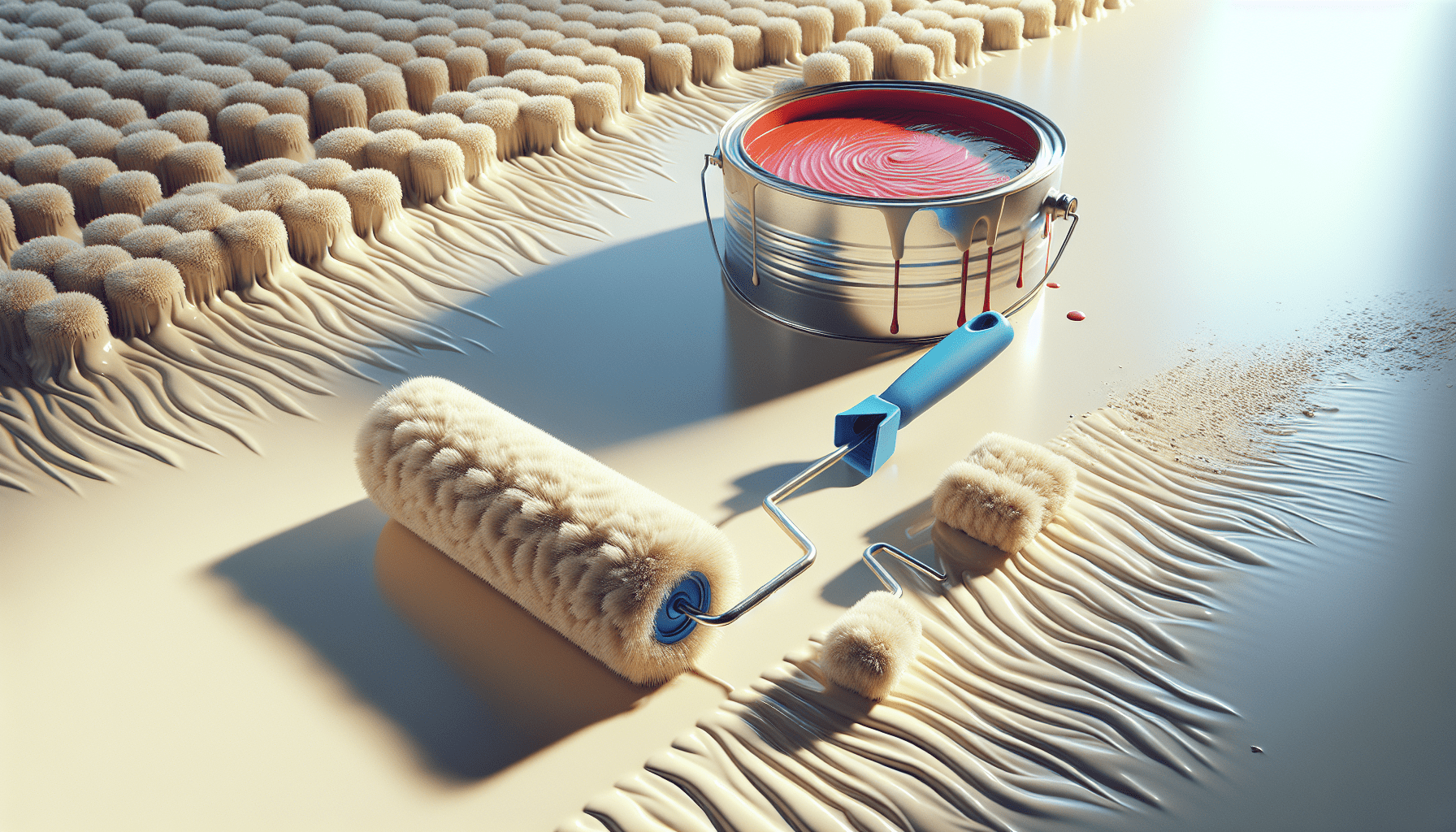Thinning epoxy paint is a crucial skill for achieving the desired consistency and smooth application. In this article, you will learn the essential steps and guidelines for properly thinning epoxy paint. Whether you’re a professional painter or a DIY enthusiast, mastering this technique will ensure that your epoxy paint projects yield professional-looking results. So let’s dive right in and discover the simple yet effective methods to thin epoxy paint effectively.
Understanding Epoxy Paint
What is epoxy paint?
Epoxy paint is a type of paint that consists of epoxy resin as the main component. It is known for its durability, resistance to chemicals and abrasion, and its glossy finish. Epoxy paint is commonly used for industrial applications such as coating floors, walls, and machinery. It offers a protective and aesthetic coating that can withstand harsh conditions and provide long-lasting results.
Why would you need to thin epoxy paint?
There are several reasons why you may need to thin epoxy paint. Thinning the paint can help improve its flow and coverage, making it easier to apply and achieve a smooth finish. Thinning is particularly important when using spray equipment, as it ensures proper atomization and prevents clogging. Additionally, thinning can help adjust the viscosity of the paint, allowing for better penetration into porous surfaces or easier application in colder temperatures. It is essential to follow the manufacturer’s instructions when thinning epoxy paint to achieve the desired consistency and ensure optimal performance.
Choosing the Right Thinner
Types of thinners for epoxy paint
When it comes to thinning epoxy paint, it is crucial to choose the right type of thinner. The type of thinner you need will depend on the specific epoxy paint you are using and the desired consistency. There are various types of thinners available, including water-based thinners, solvent-based thinners, and specialty thinners designed for specific epoxy paints. Water-based thinners are typically used for water-based epoxy paints, while solvent-based thinners are commonly used for solvent-based epoxy paints. Specialty thinners, such as epoxy reducers or epoxy flow agents, are formulated to work specifically with certain epoxy paint brands and can help achieve optimal thinning results.
Considerations when selecting a thinner
When selecting a thinner for epoxy paint, there are a few considerations to keep in mind. First, it is essential to choose a thinner that is compatible with the specific epoxy paint you are using. Different epoxy paints may require different types of thinners, so it is crucial to consult the manufacturer’s guidelines or technical data sheet for recommendations. Additionally, consider the temperature and humidity conditions during application. Some thinners may evaporate more quickly in high temperatures or humid environments, which can affect the drying and curing process. Finally, consider any specific application requirements or regulations that may influence the choice of thinner, such as VOC (volatile organic compounds) limits in certain areas.

Safety Precautions
Protective gear
When working with epoxy paint or any chemical substances, it is vital to prioritize safety and use the appropriate protective gear. Wear gloves to protect your hands from direct contact with the paint and thinner. Nitrile or neoprene gloves are recommended, as they offer excellent chemical resistance. Additionally, wear safety goggles or a face shield to protect your eyes from potential splashes or fumes. It is also advisable to wear long sleeves and pants to minimize skin exposure. If working in a poorly-ventilated area, consider wearing a respirator or a mask to protect yourself from inhaling any harmful vapors or particles.
Well-ventilated area
When thinning epoxy paint, it is crucial to work in a well-ventilated area to minimize exposure to potentially hazardous fumes. Epoxy paint and its thinners may release volatile organic compounds (VOCs) which can be harmful when inhaled in high concentrations. Open windows or doors to allow fresh air to circulate, or consider using fans or ventilation systems to improve air circulation. If working indoors, ensure there is proper exhaust or ventilation to remove any fumes or vapors. It is important to always prioritize your safety and take the necessary precautions to minimize exposure to chemicals.
Fire safety measures
Epoxy paint and its thinners are flammable substances, so it is crucial to take fire safety measures when working with them. Keep flammable materials and ignition sources away from the work area, and avoid smoking or using open flames near the paint and its thinners. It is advisable to have fire extinguishing equipment readily available, such as fire extinguishers or fire blankets, in case of emergencies. Familiarize yourself with the proper use of fire extinguishers and ensure they are appropriately maintained. By following these fire safety measures, you can minimize the risk of accidents and ensure a safe working environment.
Preparing the Epoxy Paint
Reading the manufacturer’s instructions
Before thinning epoxy paint, it is essential to carefully read and understand the manufacturer’s instructions. The manufacturer’s instructions will provide specific guidelines on how to thin the paint, including the recommended type of thinner and the appropriate ratio of paint to thinner. It will also indicate any specific precautions or considerations that need to be taken into account. By following the manufacturer’s instructions, you can ensure that you are thinning the epoxy paint correctly and maximizing its performance.
Checking the viscosity of the epoxy paint
Viscosity refers to the thickness or flow of a liquid. Before thinning epoxy paint, it is recommended to check the viscosity of the paint using a viscosity cup or a similar measuring tool. The viscosity cup is a simple device that measures the time it takes for a specific volume of liquid to flow through a small hole at the bottom of the cup. By comparing the measured flow time to the manufacturer’s specifications, you can determine whether the paint needs to be thinned and by how much. Checking the viscosity helps ensure that the paint is within the desired range for optimal application and performance.
Identifying the desired consistency
When thinning epoxy paint, it is important to have a clear understanding of the desired consistency you are aiming to achieve. The consistency will depend on the specific application requirements and the method of application. For example, if you are using a brush or roller, you may need a slightly thicker consistency compared to spray application. The desired consistency should allow for easy spreading and smooth application without compromising the paint’s performance. By identifying the desired consistency beforehand, you can thin the paint accordingly and achieve the best results.

Thinning Techniques
Optimal ratio of epoxy paint to thinner
The optimal ratio of epoxy paint to thinner will depend on various factors, including the type of epoxy paint, the desired consistency, and the specific application requirements. The manufacturer’s instructions will typically provide a recommended ratio or range of ratios to achieve the desired thinning. It is crucial to follow these guidelines to ensure that the epoxy paint is thinned properly. Adding too much or too little thinner can affect the paint’s performance, adhesion, and drying time. By adhering to the recommended ratios, you can achieve the desired consistency and ensure the best results.
Mixing the paint and thinner
To thin epoxy paint, start by pouring the appropriate amount of paint into a clean container. Gradually add the thinner to the paint, stirring continuously until the paint and thinner are thoroughly mixed. It is recommended to use a mixing stick or a mechanical mixer to ensure proper blending of the two components. Avoid adding the thinner all at once, as it can be challenging to correct the consistency if the paint becomes too thin. By gradually adding and mixing the paint and thinner, you can achieve a homogenous mixture with the desired thinning without compromising the paint’s performance.
Using a paint viscosity cup
To ensure accurate thinning of epoxy paint, you can use a paint viscosity cup to measure the viscosity of the thinned paint. Fill the viscosity cup with the thinned paint and slowly lift it out of the paint container. Measure the flow time of the paint through the hole at the bottom of the cup, following the manufacturer’s instructions for the specific cup you are using. Compare the measured flow time with the desired flow time specified by the manufacturer. If the viscosity is too high, the paint may need further thinning. If the viscosity is too low, additional epoxy paint may need to be added. By using a viscosity cup, you can fine-tune the consistency of the thinned paint to achieve optimal results.
Stirring and blending the mixture
After mixing the epoxy paint and thinner, it is important to thoroughly stir and blend the mixture to ensure a consistent and uniform thinning. Use a stir stick or a mechanical mixer to stir the paint from the bottom up, making sure to scrape the sides and bottom of the container to incorporate any settled or unblended components. Continue stirring until the paint and thinner are well-mixed and have a uniform consistency. Adequate mixing helps ensure that the paint is properly thinned and ready for application. It is important to avoid excessive stirring, as it can introduce air bubbles into the mixture, which may affect the final finish.
Testing and Adjusting
Performing a patch test
Before applying thinned epoxy paint to the entire surface, it is advisable to perform a patch test. Choose a small, inconspicuous area and apply the thinned paint using the desired application method. Observe how the paint spreads, how it adheres to the surface, and the resulting finish. Check for any signs of uneven coverage, streaks, or other imperfections. The patch test allows you to assess the thinned paint’s performance and make any necessary adjustments before proceeding with the full application. If the paint appears too thick, it may need further thinning. If the paint appears too thin, additional epoxy paint may need to be added.
Observing the flow and coverage
During the application of thinned epoxy paint, continuously observe the flow and coverage of the paint to ensure optimal results. The paint should have a smooth and consistent flow, allowing for easy spreading and coverage. If the paint appears to be too thick and does not flow well, it may require further thinning. On the other hand, if the paint appears to be too thin and flows excessively or runs off the surface, it may need additional epoxy paint. By carefully observing the flow and coverage, you can make necessary adjustments to achieve the desired consistency and ensure proper application.
Adjusting the thickness if necessary
If, during the application process, you find that the epoxy paint is not reaching the desired thickness or consistency, adjustments can still be made. If the paint is too thick, gently stir in a small amount of the recommended thinner until the desired consistency is achieved. Alternatively, if the paint is too thin, add a small amount of epoxy paint and mix thoroughly to reach the desired thickness. It is important to make adjustments in small increments, as adding too much thinner or paint at once can significantly impact the final result. Regularly evaluate the thickness and consistency of the paint during application and make adjustments as necessary to achieve the best outcome.
Application Tips
Proper surface preparation
Before applying thinned epoxy paint, proper surface preparation is essential to ensure optimal adhesion and longevity of the coating. Start by thoroughly cleaning the surface, removing any dirt, dust, grease, or other contaminants that may compromise the paint’s adhesion. If necessary, use a mild detergent or a degreaser to clean the surface effectively. If the surface has any existing coatings or loose paint, it is recommended to remove them before applying the epoxy paint. Additionally, ensure that the surface is dry and free from moisture, as dampness can affect the paint’s performance. By properly preparing the surface, you can enhance the paint’s adhesion and achieve a long-lasting finish.
Using the correct tools
Using the correct tools is crucial when applying thinned epoxy paint. The tools you choose will depend on the specific application method and the surface being painted. For large surfaces, such as floors or walls, a roller or a paint sprayer may be the most efficient choice. Select a high-quality roller or sprayer suitable for epoxy paint and follow the manufacturer’s recommendations. If applying epoxy paint to smaller areas or intricate details, a brush or a foam brush may be more suitable. Ensure that the brushes or foam brushes are clean and free from loose bristles before use. Using the correct tools will help ensure even application, smooth finishes, and optimal coverage.
Applying multiple thin coats
When applying thinned epoxy paint, it is often recommended to apply multiple thin coats rather than a single thick coat. Thin coats ensure better adhesion and allow for proper drying and curing between coats. Apply each coat evenly and consistently, following the manufacturer’s recommended drying time between coats. Multiple thin coats also make it easier to control the thickness and appearance of the final finish. It is important to avoid applying heavy coats, as they can lead to sagging, runs, or other imperfections. By applying multiple thin coats, you can achieve a more uniform and professional-looking finish.
Drying and Curing
Understanding the drying and curing process
The drying and curing process of epoxy paint involves the physical and chemical changes that occur as the paint goes from a liquid to a solid state. Drying refers to the evaporation of solvents, water, or other volatile components in the paint, whereas curing refers to the chemical reaction that causes the paint to harden and develop its desired properties. The drying time and curing time of epoxy paint can vary depending on several factors, including temperature, humidity, thickness of the paint layers, and the specific epoxy paint product. It is important to follow the manufacturer’s instructions regarding the recommended drying and curing times to ensure that the paint fully dries and cures properly.
Factors affecting drying time
Several factors can influence the drying time of thinned epoxy paint. Temperature and humidity are two critical factors that can significantly impact drying time. Higher temperatures and lower humidity levels generally result in faster drying times, while lower temperatures and higher humidity levels can prolong the drying process. The thickness of the paint layers can also affect drying time, as thicker layers may take longer to dry compared to thinner layers. Proper ventilation and air circulation can help expedite the drying process, while inadequate ventilation or high humidity conditions can lead to extended drying times. By considering these factors, you can plan your painting project accordingly and ensure that the paint dries within the recommended time frame.
Ensuring proper curing conditions
Proper curing is crucial to achieving the maximum performance and longevity of thinned epoxy paint. Curing typically involves the completion of a chemical reaction that allows the paint to achieve its desired properties, such as hardness, durability, and chemical resistance. To ensure proper curing, it is important to provide the necessary curing conditions. Follow the manufacturer’s instructions regarding the recommended curing time and conditions, including temperature and humidity requirements. Typically, the curing process requires a certain minimum temperature and humidity level to facilitate the chemical reactions. Failing to provide proper curing conditions can result in inadequate adhesion, reduced durability, or other performance issues. By allowing the paint to cure properly, you can ensure optimal results and long-lasting protection.
Clean-up and Storage
Cleaning painting tools
After the application of thinned epoxy paint, it is important to promptly clean your painting tools to maintain their performance and prolong their lifespan. Thoroughly clean brushes, rollers, sprayers, or any other tools used with epoxy paint. Begin by removing excess paint from the tools using a scraper or a putty knife. Then, rinse the tools with an appropriate solvent or cleaner recommended by the manufacturer. Use a brush or a sponge to remove any remaining paint thoroughly. Rinse the tools with water or the recommended cleaning solution to ensure they are free from any residue. Allow the tools to air dry or follow any additional cleaning instructions provided by the manufacturer. Proper cleaning and maintenance of your painting tools will ensure their continued effectiveness and prolong their usability.
Disposing of leftover thinned epoxy paint
Proper disposal of leftover thinned epoxy paint is important to protect the environment and comply with local regulations. It is recommended to consult local authorities or waste management facilities to determine the specific disposal requirements in your area. In many cases, leftover paint can be brought to designated collection points or hazardous waste facilities. Avoid pouring thinned epoxy paint down drains or into the soil, as it can contaminate water sources or harm the ecosystem. By disposing of leftover paint responsibly, you contribute to environmental sustainability and help protect the ecosystem.
Proper storage of epoxy paint and thinner
To ensure optimal shelf life and performance, it is important to store epoxy paint and its thinner properly. Epoxy paint should be stored in a tightly sealed container to prevent air exposure, contamination, and drying. Keep the container in a cool and dry place away from direct sunlight or extreme temperature fluctuations. It is advisable to store epoxy paint at an optimal temperature recommended by the manufacturer to maintain its properties and consistency. Thinner should also be stored in a sealed container and kept in a well-ventilated area away from heat sources and open flames. By following proper storage practices, you can extend the shelf life of epoxy paint and its thinner and ensure their continued usability.
Common Mistakes to Avoid
Over-thinning the epoxy paint
One common mistake when thinning epoxy paint is over-thinning, which can result in decreased adhesion, reduced durability, and compromised performance. Adding too much thinner can weaken the paint film and affect its ability to adhere to the surface. Over-thinning can also lead to excessive flow or sagging, resulting in an uneven or inconsistent finish. It is important to carefully follow the manufacturer’s instructions and only add the recommended amount of thinner to achieve the desired consistency. If necessary, make adjustments gradually and perform patch tests to ensure the thinned paint still performs as intended.
Adding too much thinner at once
Adding too much thinner to epoxy paint at once can make it challenging to correct the consistency if the paint becomes overly thin. It is recommended to add the thinner gradually, stirring continuously and periodically checking the viscosity with a viscosity cup or a similar measuring tool. By adding the thinner in small increments, you can achieve the desired consistency without going beyond the recommended thickness. If the paint becomes too thin, it may be necessary to add additional epoxy paint to restore the proper thickness. It is always easier to make small adjustments throughout the thinning process rather than trying to correct an excessively thinned paint.
Neglecting safety precautions
Neglecting safety precautions when working with epoxy paint and its thinners can pose risks to your health and safety. Always prioritize your safety and follow the appropriate safety guidelines and precautions. Wear the recommended protective gear, such as gloves, goggles, and appropriate clothing, to protect yourself from the paint and any potential hazards. Work in a well-ventilated area to minimize exposure to fumes and ensure proper air circulation. Take fire safety measures by keeping flammable materials away from the work area and having fire extinguishing equipment readily available. By practicing proper safety precautions, you can minimize the risk of accidents and ensure a safe working environment.
Thinning epoxy paint is an essential step in achieving optimal results and ensuring the best performance of the paint. By understanding the process, choosing the right thinner, and following the proper techniques and precautions, you can successfully thin epoxy paint and achieve a professional-looking finish. Remember to always read and follow the manufacturer’s instructions, perform patch tests, and make necessary adjustments to achieve the desired consistency. With proper thinning, application, and care, epoxy paint can provide long-lasting protection and enhance the appearance of various surfaces in both industrial and personal projects.



